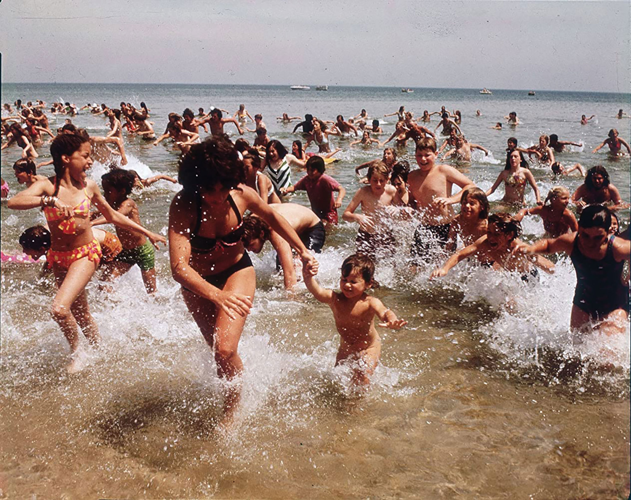
Jaws
Wear a mask. That tiny effort can make all the difference in the world. If you insist on not wearing one, how about you insist on staying away from other people? We are at a scary point, and it is very hard to give anyone the benefit of the doubt anymore about much of anything. Letterkenny has been helping. And Chromeo’s Quarantine Casanova EP has definitely distilled a surprisingly large percentage of COVID-based anxiety into some tasty grooves. But wear masks, please. It’s the least you can do.
Below is this week’s batch of recommended streaming titles. Look back at the 15 past issues of the Scene for more recommendations: March 26, April 2, April 9, April 16, April 23, April 30, May 7, May 14, May 21, May 28, June 4, June 11, June 18, June 25, July 2.

The Beach House
The Beach House on Shudder
A quaint romantic getaway/relationship progress report for Emily and Randall is left in stasis by an error in timing (which could be the setup to a farce in another film), and then by a cosmic upheaval. Firstly, the family beach house is currently occupied by unexpected friends of the parents. That’s weatherable, as Mitch and Jane are kindhearted and charming, and they’re actually fun to spend some time with. Nobody’s out to murder or harvest organs from anyone — just good meals and maybe some board games and this lovely scenery. But there’s something gathering, spreading, swarming. In the skies. In the ocean. In organic bodies. There’s a little bit of Annihilation to The Beach House, and some Lovecraftian spice, and an honest reckoning with the cruelties of fate. But there’s no previous hangout movie that successfully becomes a surreal apocalyptic nightmare to fully compare this to, and as such The Beach House is low-budget genre cinema done beautifully and viscerally. There’s beauty in the cellular brutality, and Liana Liberato as Emily is an inspiring and resourceful heroine.
The Jaws Quartet on HBO Max
Can we talk about Jaws? It’s recently been on the collective digital mind of folks, judging from the internet memes equating the film’s Mayor Vaughn with countless real-life figures on the federal, state and local level. And that’s certainly a visceral enough way into the story, because you can’t get past the shortsighted foolishness of throwing the public into the breach — hearing people’s derisive reactions to that character’s dialogue during a recent drive-in screening of the first film was a teeny little triumph amid the ongoing dejected and fatalistic sigh of the past few months ... because yeah, fuck that guy. There need to be better options than staying open in the face of needless death. So while we’re trying to figure out something better than capitalist oligarchy, this quartet of shark narratives is a good way to explore studio economics and the law of diminishing returns in an afternoon.
Jaws (1975) is a classic that defined the modern Summer Movie Blockbuster as we know it. It still plays like gangbusters and will make you deeply nervous around water. Jaws 2 (1978) is a superb slasher movie — it doesn’t have as much on its mind as the progenitor, but there are set pieces in here (shark-versus-teen-boaters is a personal fave) to rival the greats of ’70s horror, and it does the Psycho II trick of being so much better than it has any right to be. Jaws 3-D (1983) is fine, using 3D (if you have this film on Blu-ray, you already have the 3D version as an option should you have the right AV setup) and its location (SeaWorld, which is just as problematic as you want from a place whose clientele is going to get eaten with relish, figuratively and probably literally) beautifully. It’s got Louis Gossett Jr. and Dennis Quaid to add some respectability to the proceedings. Jaws: The Revenge (1987) has that amazing Percy Rodrigues-narrated trailer (“This time ... it’s personal”) and a sadly excised voodoo subplot, but it’s also an attempt to give Lorraine Gary something to do after 12 years and too many folk lost. Also, Michael Caine.
Gothic on Tubi
Ken Russell, at the peak of his ’80s genius excess, tells us the story of that fateful weekend in 1816 at the Villa Diodati on Lake Geneva in Switzerland, where Mary Godwin (the late, truly great Natasha Richardson), Lord Byron (Gabriel Byrne at his haughtiest), Percy Shelley (Julian Sands, splitting the difference between his Merchant Ivory collaborations and the Warlock series), Dr. John Polidori (Timothy Spall, snivelicious) and Claire Clairmont (Myriam Cyr) gathered for debauchery and storytelling. Take a cast like that, an electrical brilliance like Russell’s, add hallucinogens and deep-seated regret, and stir! Gothic is the story of how we as a culture were given Frankenstein and his monster by Mary, as well as the modern conception of the vampire myth from Polidori, as well as further decadent work from Shelley and Byron. It’s a fortuitous gathering of creative minds, expressed via Russell’s vision (and Thomas Dolby’s gloriously anachronistic score) as a fever dream, a séance, a nightmare, a seduction and an exorcism — and it is glorious. Russell’s subsequent film, The Lair of the White Worm, is also essential viewing for anyone who delights in the obliteration of the division between classy and trashy.

Woodshock
Woodshock on Netflix
You might have missed this hypnotic dreamscape when it played upstairs at the Belcourt for a couple of days in the long, long ago of 2017. Crafted out of brainwaves and weed fumes as well as West Coast forest secrets and refracted high-end glitz, Woodshock sees the fashion-designer Mulleavy sisters building something different from their Rodarte line, and exorcising anxiety in a visually and tonally distinctive fashion as co-directors. Their work has always gathered seeds of inspiration from genre culture, and you can feel that sense of protean “anything unspeakable can happen” seeping out of every frame. Kirsten Dunst as dispensary tech/folk physician Theresa creates a bookend for her 2011 Cannes Best Actress Award-winning performance in Melancholia, here focusing on a world-altering trauma that emanates from within rather than without, metabolizing grief and guilt and the very act of keeping your shit together when nothing makes sense and tragedy is the engine that drives the universe. This one isn’t for everybody, but if you want something that understands the psychological mechanics of “living” when it feels like everything is underwater (or suffused with some other, thicker humor) — or if you’re interested in seeing the vision of two incredibly gifted artists who are not concerned with explosions or patriarchal successions — this is exactly what you need. If you’ve just baked some cookies and have a box of wine stashed somewhere, you are ready for this distinctive and druggy work of overwhelming beauty.







